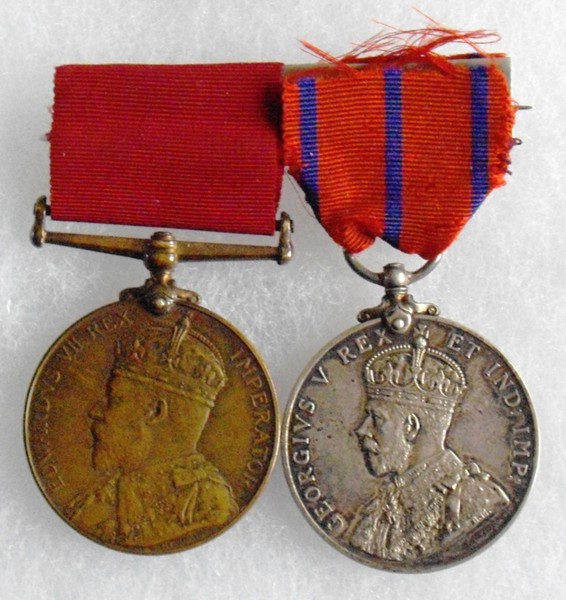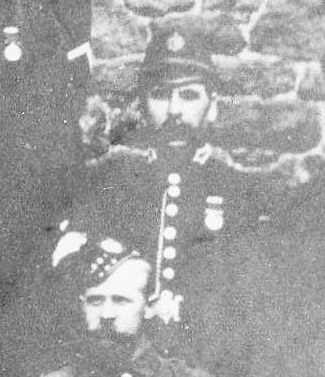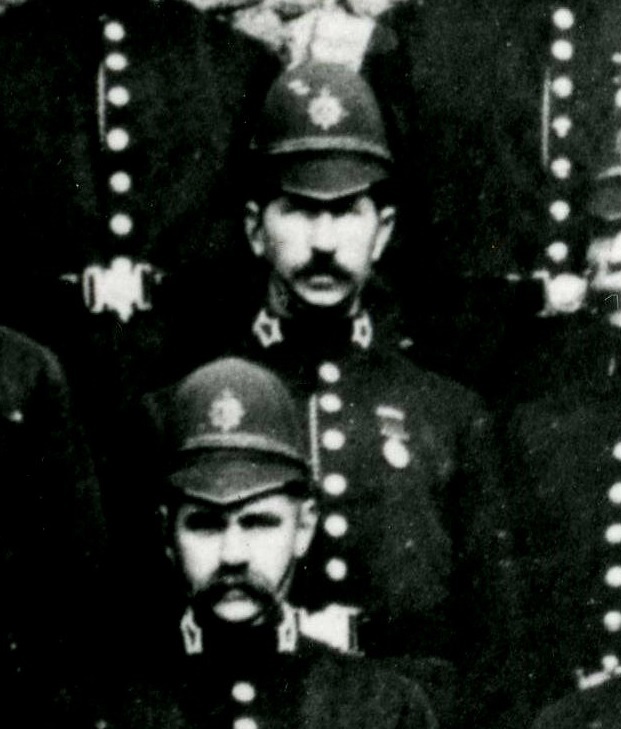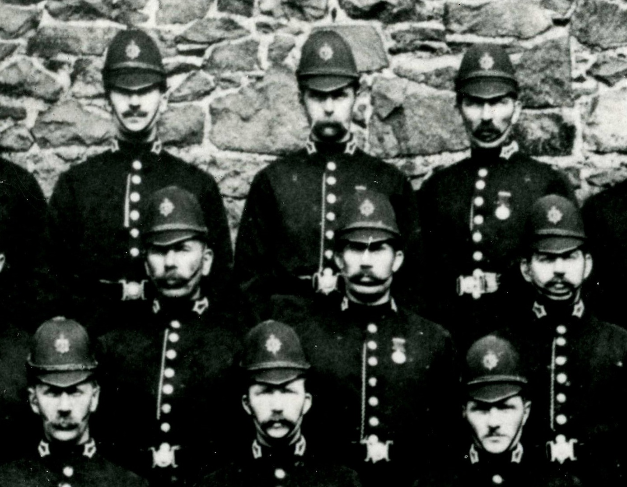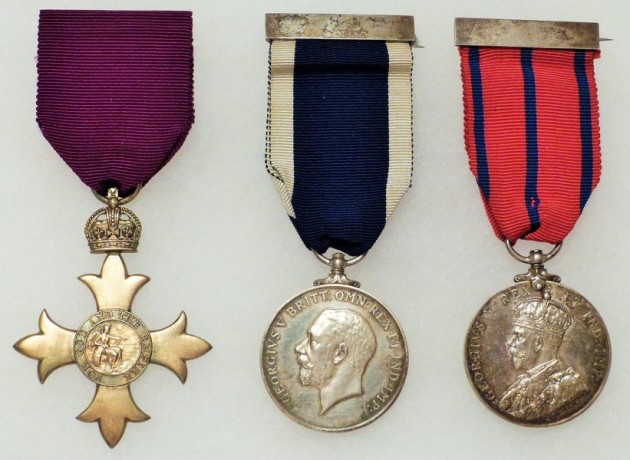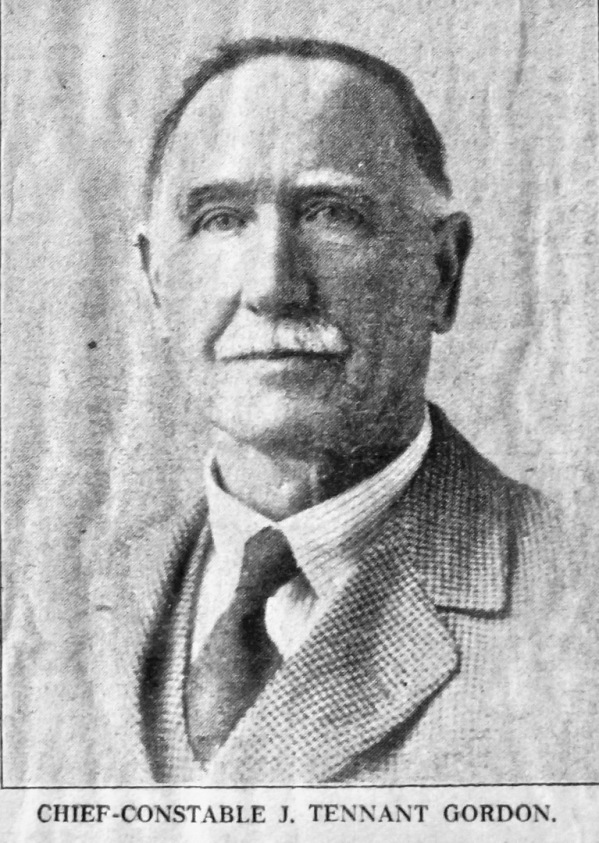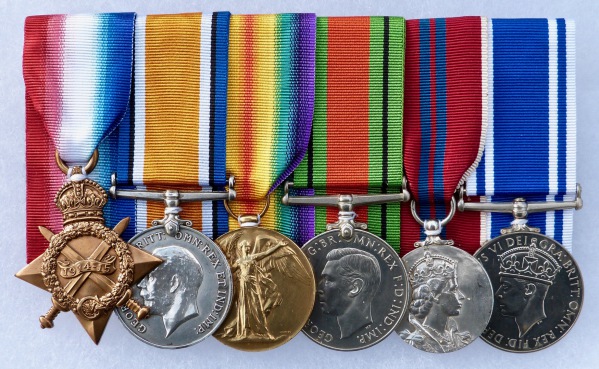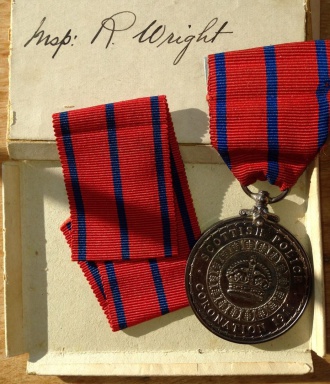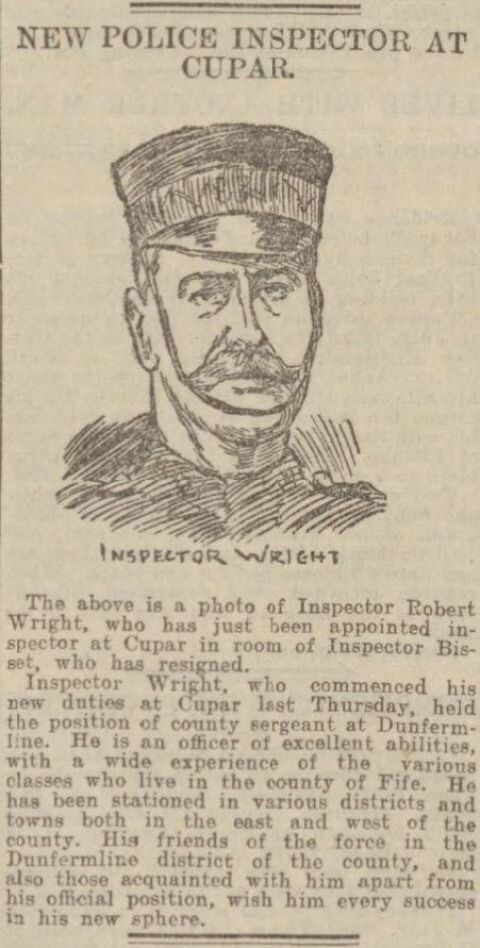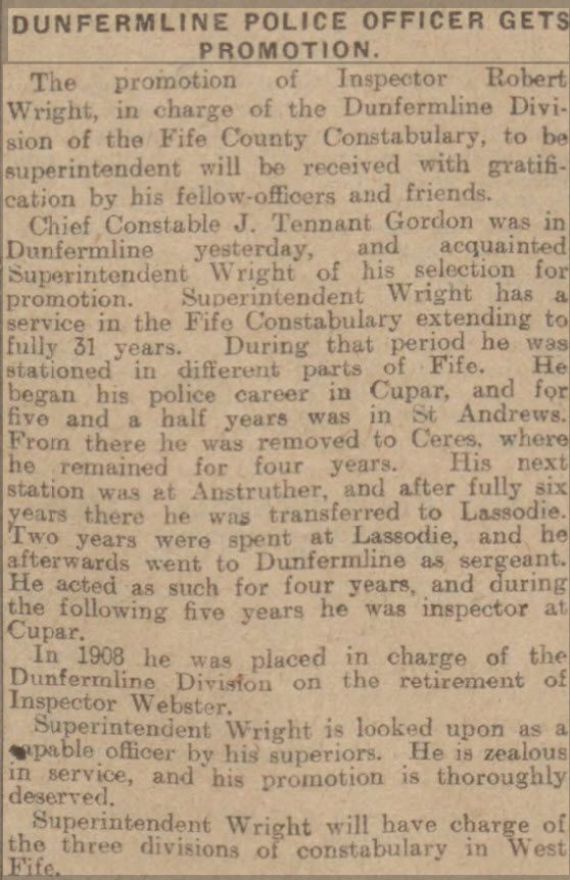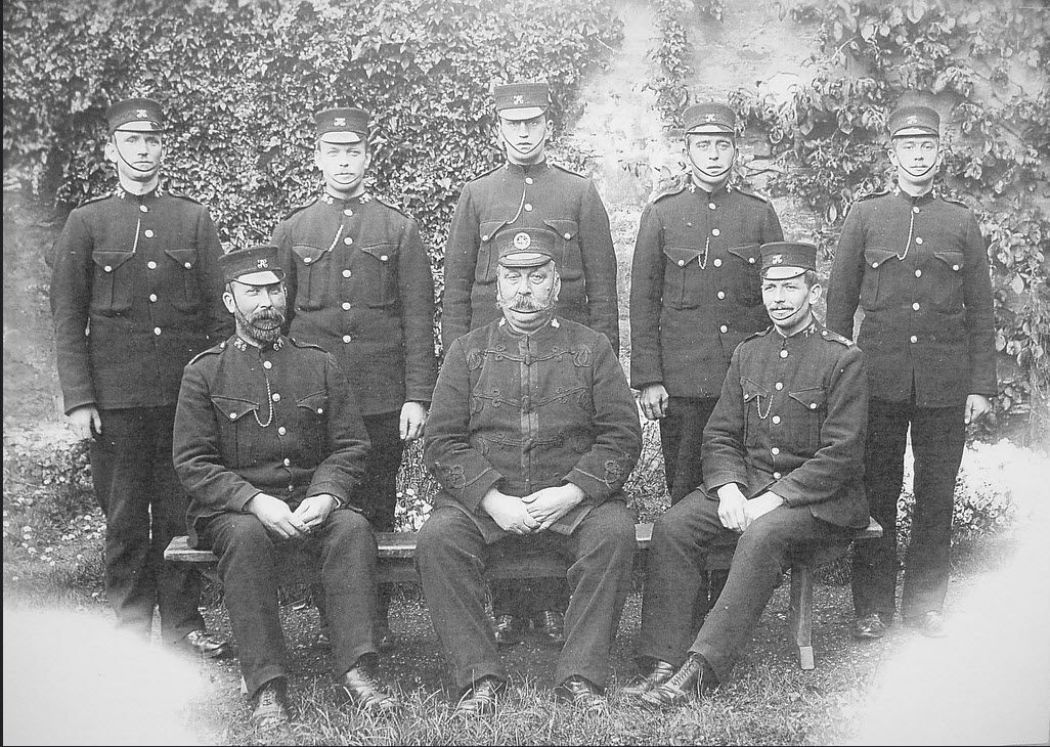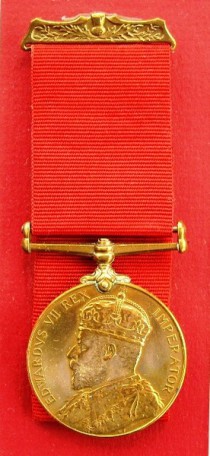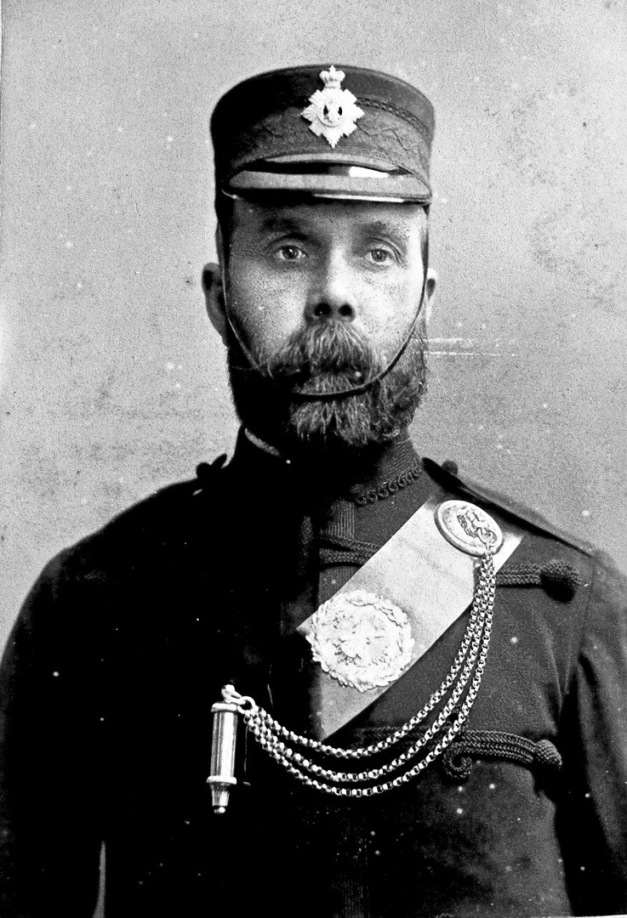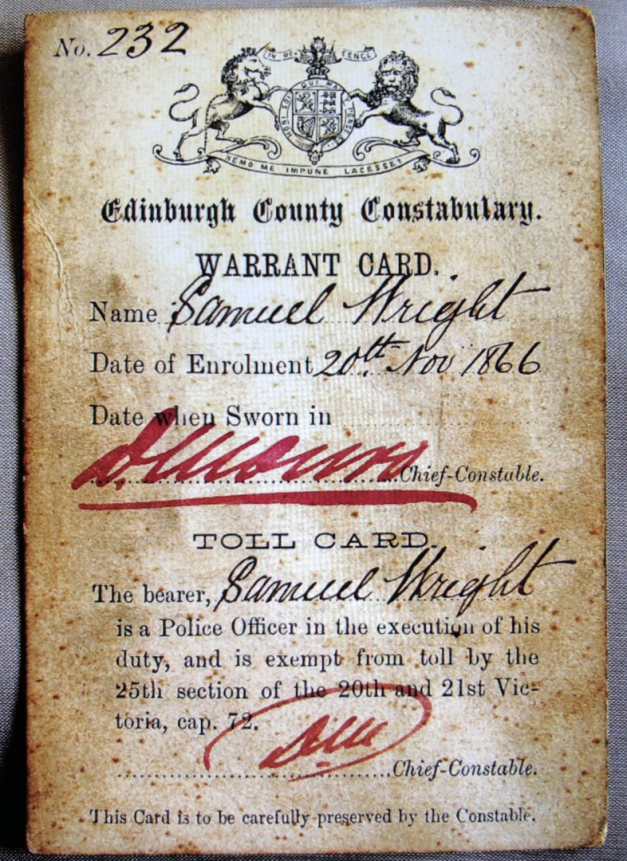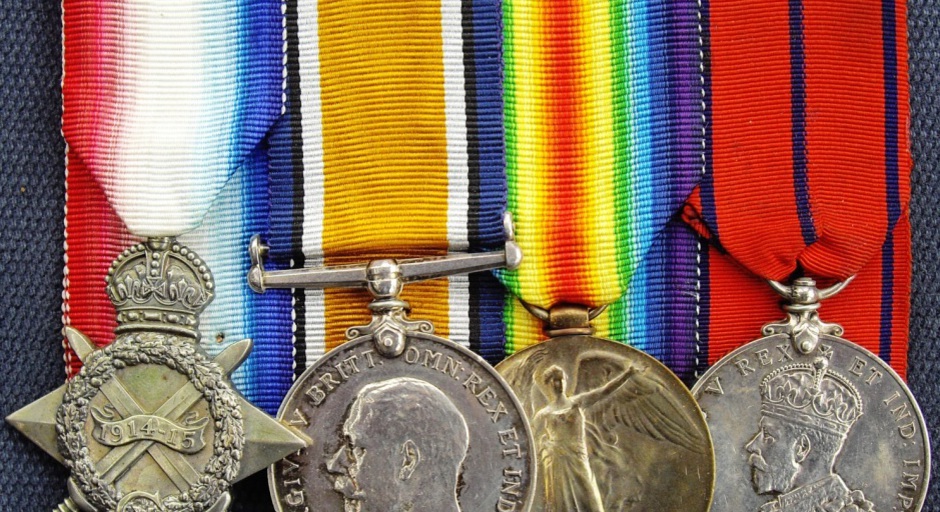
East Lothian Constabulary to Mid Lothian Constabulary
East Lothian Constabulary 1832 1950
PS Peter Haig
King Edward VII Police (Scotland) Medal 1903
King George V Coronation (Scottish Police) Medal 1911
East Lothian Constabulary
PS Peter Haig
Peter Haig was born on 23 October 1861 near Jedburgh in the County of Roxburgh.
He was a Ploughman when he married Jessie Ellen Scott at Crailing in the County of Roxburgh in 1882.
He joined East Lothian Constabulary on 31 March, 1887 and was posted to Dunbar Police Station.
He was stationed at Garvald in 1891 and East Linton in 1896.
By 1901, he was back in Dunbar as Acting Sergeant. It was there that his wife, Jessie, died in 1907.
On 16 December, 1910, Police Sergeant Peter Haig of the Police Station, Tranent, married Christina Fairburn at Coldstream in the County of Berwick.
Acting PS Peter Haig retired from East Lothian Constabulary on 15 April, 1921 with 34 years. His annual Pension was £168, 3/8d (£168. 18p).
Christina died in Coldstream in 1934 aged 66.
Peter Haig died in Coldstream on 18 November, 1940 aged 79.
(Picture of PS Haig courtesy of East Lothian Council Archives)
East Lothian Constabulary
In an invoice dated 3 October, 1912, a ‘Military Contractor, Manufacturer and Warehouseman’ called A. C. Heath of 1-5 Barrack Road, Hounslow, London billed PC John Hastie of East Lothian Constabulary based at the Burgh Police Office in Tranent for “1 yard each of 1911 and 1903 Scottish Police medal ribbons @ 1/- a yard”.
The ribbon was enclosed in the brown envelope shown below addressed to PC Hastie at Tranent. Within the envelope was a smaller envelope addressed to ‘Sgt. Haig’ with the number ‘2’ presumably meaning the number of ribbons.
The actual ribbons can also be seen in the picture below.
The envelope addressed to ‘Sgt. Haig’ is in the same handwriting as that on the envelope further down which is addressed to “Pc Harper, Medal Ribbons, 2”.
It is possible PC Hastie did a bulk order for a few of the East Lothian officers?
East Lothian Constabulary 1832 1950
PC Alexander Harper
King Edward VII Police (Scotland) Medal, 1903
King George V Coronation (Scottish Police) Medal, 1911
East Lothian Constabulary
PC Alexander Harper
Alexander Harper was born on 31 January, 1864 at Bridgefoot of Boyndie in the County of Banff. His father was James Gordon, an ‘Agricultural Labourer’ and his mother, Ann Forsyth or Harper. His parents were married on 23 January, 1864 at Banff.
Mary Ann Gordon was born 3 October, 1863 in the Parish of Cabrach in the County of Aberdeen (but which is in Banffshire).
On 6 December, 1884, after Banns according to the Forms of the Established Church of Scotland, Alexander Harper, Farm Servant, (20), married Mary Ann Gordon, Domestic Servant, (20), at Silverford in the Parish of Auchendoir and Kearn in the County of Aberdeen.
The couple had three children over the next five years, Ann Thomson Harper, born in Auchendoir, Aberdeenshire, Isabella Harper, born in Marnoch in Banff and Alexander Gordon Harper, born in Forgue in Aberdeenshire.
On 22 November, 1889, Alexander Harper was appointed to East Lothian Constabulary as a 3rd Class Constable and posted to Ormiston Police Station.
His Personnel Record shows that he was “24 years, 5’10.5”, 13 stones”, with “Blue eyes, Brown hair and Fresh complexion”.
It was in the County Police Station in Ormiston on 6 February, 1890 that Mary Jessie Gordon Harper was born.
The family were still there in the Census of 1891 and later that year, on 24 November, PC Harper was promoted to 2nd Class Constable.
He was transferred to Gifford in the Parish of Yester on 20 June, 1892. On 22 November that year, he was promoted to 1st Class Constable.
It was in Gifford that Maggie Forsyth Harper was born on 4 February, 1895 and, on 9 April, 1898, James Harper was born.
PC Harper was transferred to Gullane Police Station on 5 July, 1898.
In the Census of 1901, with the exception of Ann Thomson Harper, the rest of the family were now living at Hopetoun Place (Main door), Dirleton.
By the Census of 1911, only Alexander, Mary Ann, Maggie and James were living in Dirleton at 4 Hopetoun Place.
On 16 April, 1918 he was ‘Advanced to Merit Class’.
He retired on pension from East Lothian Constabulary “on completion of service” on 28 November, 1922.
At Belhaven Hospital, Dunbar on 24 September, 1942, Mary Ann Harper, (78) married to Alexander Harper, Police Constable (retired), died. Her husband of 42 Hopetoun Terrace in Gullane, registered her death.
On 6 January, 1943, at 40 Henderson Row, Portobello in Edinburgh, Alexander Harper, (78), Police Constable (Retired) and Widower of Mary Ann Gordon, died. His usual address was 42 Hopetoun Terrace, Gullane.
His son Alexander Harper of 40 Henderson Row, Portobello registered his death.
Fife County Police 1840 - 1949
Chief Constable William Tennant Gordon OBE KPM
Officer of the British Empire (GVR)
King's Police Medal (GVR)
King George V Coronation (Scottish Police) Medal 1911
Fife and Kinross Constabulary
Chief Constable James Tennant Gordon OBE KPM
James Tennant Gordon was born in Monymusk in the County of Aberdeen in 1865.
He joined Ayrshire Constabulary on 1 November 1884 and was promoted to Sergeant on 26 October 1891.
In 1895, he transferred to Hamilton Burgh Police as Inspector and Deputy Chief Constable.
Later that year, he was appointed Superintendent and Deputy Chief Constable of the County of Wigtownshire Police.
In June 1898, he was appointed Chief Constable of Banffshire Constabulary.
He was appointed Chief Constable of Fife and Kinross in December 1903. He commenced his duties on 16 January 1904.
After Local Government reorganisation in 1929, he ceased responsibility for Kinross when it was transferred to Perthshire.
James Tennant Gordon died in office while playing golf with the Provost of Cupar at Eden Sands Golf Course in St Andrew's on 24 November 1934.
To contact the Dumfries & Galloway Police Museum, please click on the link here:
Fife Constabulary 1840 - 2013
Superintendent Andrew Mitchell
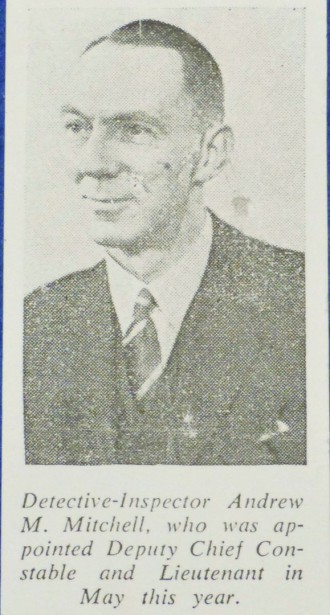 Superintendent Andrew M Mitchell Fife Constabulary taken in 1942 while still with Dunfermline City Police
Superintendent Andrew M Mitchell Fife Constabulary taken in 1942 while still with Dunfermline City Police
1914-15 Star
British War Medal
Victory Medal
The Defence Medal
The Coronation Medal 1953
Police Long Service & Good Conduct (GVIR)
Dunfermline City Police
Fife Constabulary
Superintendent Andrew Mitchell Mitchell
Andrew Mitchell was born at Colton of Pittencrieff Farm, Dunfermline on 26 March, 1896. His father, Ebenezer Mitchell, a Flesher worked for his brother-in-law, John Marshall, the owner of the farm. Andrew Mitchell’s mother was Janet Marshall or Mitchell.
There is no middle name on Andrew Mitchell’s birth certificate.
The family were still living at Colton of Pittencrieff in the Census of 1901 when Ebenezer’s occupation is ‘Butcher’.
By the Census of 1911, the family were living at 48 Golfdrum Street in Dunfermline. Ebenezer was still a Butcher, he and Janet had been married 18 years, had six live births together, all six children of whom were still alive at the date of the Census.
Andrew was 15 and working as a Butcher.
On 8 August, 1914, according to his Personnel Record in Dunfermline City Police, Andrew Mitchell Mitchell was appointed as a ‘Temporary Additional Constable’ for the duration of the First World War. However, on 21 May, 1915, he was “Granted leave of absence to join the Army for the duration of the War.” The entry is signed by “George Bruce, Chief Constable”.
From his Army record, he enlisted the same day in the Army Service Corps (later to become the Royal Army Service Corps) as Private No. S4/094863 with the trade of Butcher.
He was posted to France arriving on 16 December, 1915. He later served in the Royal Engineers and the Labour Corps in France.
According to the record of Special Constables appointed to Dunfermline City Police on 10 May, 1915, “Ebenezer Mitchell, a Labourer (in H.M. Dockyard, Rosyth) 47 and 5’ 9”” of 48 Golfdrum street, Dunfermline” was issued with “1 baton, 1 whistle and chain, 1 armband and 1 copy of instructions” for which he signed his name in the register.
Andrew M Mitchell was commissioned as a 2nd Lieutenant in the Labour Corps on 16 April, 1918.
An entry in his Police Personnel Record dated 21 December 1918, states: “While still serving in the (?) Army and having attained the rank of Lieutenant, he resigned his appointment as a Temporary Additional Constable.” This entry is also signed by “George Bruce, Chief Constable”.
Andrew Mitchell’s Medal Index Card (MIC) confirms his entitlement to the 1914-15 Star, British War Medal (BWM) and Victory Medal (VM). The 1914-15 Star is confirmed in Medal Roll RASC/5B4/3594 with the correct service number but the rank is shown as Sergeant. His entitlement to the BWM and VM are confirmed in Medal Roll Labour Corps Off/225/194 where his rank for both medals is 2nd Lieutenant.
The next entry on his Police Personnel Record dated 20 January, 1920 states: “Appointed to Permanent Force on this date. Service as a Temporary Constable to count as of 8 August, 1914 (Signed) George Bruce, Chief Constable.”
According to his MIC, Andrew Mitchell applied for his medals on 12 September, 1921 when his address was '115 Chalmers Street, Dunfermline, Fife'.
On page 10 of 'A Pictorial History of Fife Constabulary' (Published in 1999 by Fife Constabulary to celebrate the amalgamation of the three previous forces in 1949) is a picture showing the Dunfermline City Police in 1911. The box below shows a direct quote from the booklet:
|
“Dunfermline City Police C. 1911. With the extension of the Burgh boundary that year, Which included H.M. Dockyard, Rosyth, 2 Constables were added to the strength of the Force making a total of 1 Chief Constable, 1 Inspector, 2 Sergeants, 2 Acting Sergeants and 17 Constables.
The latter were increased by another 7 officers with the commencement of hostilities in 1914. Three Temporary Constables were recruited to the Regular Force for the period of the war and 350 Special Constables were also enrolled to assist the Regulars.
Twelve Dunfermline men served in the Army, and one in the Navy, with their jobs left open for them to return after the war ended.
All of those on active service subsequently returned to duty with the exception of PC Thomas Lothian who was killed in action in 1917.”
|
So far, I have not found his complete police career history but know from the newspaper cutting above that around 1942, Andrew M Mitchell was promoted to Lieutenant and Deputy Chief Constable after John Ritchie Inch became Chief Constable of Dunfermline City Police that year.
In 1949, Dunfermline City Police and Kirkcaldy Burgh Police amalgamated with Fife County Police to become Fife Constabulary.
I have also confirmed, courtesy of Police Scotland and Fife Council Archives that Superintendent Andrew M Mitchell retired on Pension from Fife Constabulary on 26 March, 1956.
I am grateful to the staff of Fife Council Archives and Police Scotland for their assistance in researching Andrew Mitchell’s police career.
Fife Constabulary 1840 - 2013
Inspector Robert Wright
Fife Constabulary
Inspector Robert Wright
This medal is a bit of a mystery.
- It was offered for sale in February, 2015 on EBay by a seller from who described it as being a “Medal named to Inspector R. Wright. Insp. Wright was an Inspector in the Dunfermline Constabulary.”
I was initially outbid on the medal but then it was withdrawn for sale for “There being an error in the seller’s description.” I contacted the seller to enquire but heard nothing back?
- There is no record of Robert Wright being awarded the 1911 medal in the Police Review and Parade Gossip issues of 1912.
However, according to the Scotland Census of 1911, “Robert Wright, (52), Inspector of Police, Fifeshire Constabulary, was living with his wife, Catherine Wright, (55) and their daughter, Catherine Wright, (15) at 53 Golfdrum Street in Dunfermline.”
He and Catherine had been married for “33 years”, had 3 children together, all of whom were still alive at the date of the Census.
Robert wright had been born in Aberdour in Fife, his wife in Cowdenbeath in Fife and their daughter in Anstruther in the County of Fife. Given his age and rank, and the fact that Anstruther was a County Station, he is more likely to be a County Police officer rather than Dunfermline Burgh Police. I am happy to correct this entry if further evidence disproves the above.
I have added his name to the Coronation (Scottish Police) Medal, 1911 medal roll as an officer in Fife Constabulary.
10 August, 2015 The mystery is solved! Please see below.
Kincardineshire Constabulary 1841 - 1949
Chief Constable Charles George
Mid Lothian Constabulary 1840 - 1950
Deputy Chief Constable Samuel Wright
King Edward VII Police (Scotland) Medal 1903
Mid Lothian County Police (The County Police of Edinburgh or Edinburghshire Constabulary)
Deputy Chief Constable (Superintendent) Samuel Wright
Samuel Wright was born on 28 February 1843 at Roxburgh Mains in the County of Roxburgh.
He joined the County Police of Edinburgh on 20 November 1866. In December that year, he married Margaret Gourlay.
Samuel Wright served as a Constable at Davidsons Mains, in the Parish of Cramond near Edinburgh, Granton, Dalkeith and Gorebridge as well as at Headquarters in the Midlothian County Council Buildings in Parliament Square, Edinburgh.
He died in service as Deputy Chief Constable of Mid Lothian Constabulary on 2 November 1909 in Edinburgh.
The Scotsman newspaper edition of Thursday 4 November 1909 reported the following:
|
“Death of the Mid Lothian Deputy Chief Constable
The death is announced at his residence, Jordan Lane, Edinburgh, of Mr Samuel wright, Deputy Chief Constable of Mid Lothian.
Mr Wright had been in indifferent health for some time past. He had been off duty about a fortnight and it was arranged that he should undergo an operation this week for an internal malady, but he died before that took place.
A native of Roxburgh, where he was born 64 years ago, Mr wright joined the Mid Lothian Constabulary in 1866. He was made a Sergeant in 1878, and in that capacity was stationed at Dalkeith and subsequently at Headquarters.
In 1884 he was promoted Inspector and went to Portobello, and in 1887 he became Superintendent and Deputy Chief Constable.
On that occasion, the residents of Portobello made him a presentation on his removal to Edinburgh.
He had served under four Chief Constables, Mr List, Mr Johnston, Captain Munro and Colonel Borthwick.
A capable and intelligent officer, Mr Wright had the confidence of his superiors, was well liked in the force, and was respected among the public among whom he served.
Mr Wright held a Certificate in Competency in Sanitary Science and in 1890 he acted as County Sanitary Inspector for a year until permanent arrangements were made.
In the course of his career as a police officer, the deceased had some exciting experiences. These included a fight with a gang of poachers on the Queensferry Road in 1871; and on the same road, he was badly mauled by a drunken Irishman he was trying to arrest. He had to go off duty with slight concussion of the brain. On an occasion in 1878, while at Stow, he had an exciting struggle on the River Gala with a navvy. A number of half-drunken (of whose) comrades stoned the officer.”
|
On Monday 8 November 1909, the Scotsman reported the following:
|
Funeral of Deputy Chief Constable Wright:
On Saturday afternoon, the funeral of the late Deputy Chief Constable Wright, of the Mid Lothian Police took place form his residence at Jordan Lane to Bath Street Cemetery, Portobello.
The cortege was followed by a large gathering of relatives and friends, and the County and City Police forces were well represented.
There were present among the mourners, Chief Constable Ross, deputy Chief Constable Chisholm and Superintendents Moyes and Forbes of the City Police; Lieutenant Colonel Borthwick and Superintendents Robertson, Dickson and Mann representing the police of Mid, East and West Lothian; Colonel Trotter and Mr A.G.G. Asher of the County Council; Mr R.W. Renton, Procurator Fiscal of the County; and Mr W.B. Robertson, W.S. J.P., Fiscal of the County.
On arrival at the cemetery the mourners were considerably augmented by members of the County Constabulary.
A number of beautiful wreaths were placed over the grave, notable among which was a handsome everlasting wreath on a marble pedestal, subscribed for by members of the Constabulary in token of their esteem for the late officer.”
|
This is Samuel Wright’s only police medal entitlement.
To see a picture of DCC Wright and his Warrant Card, click here.
Mid Lothian Constabulary 1840 - 1950
PC Thomas Moffat
King Edward VII Police (Scotland) Medal 1903
Mid Lothian Constabulary
PC Thomas Moffat
Thomas Moffat was born on 21 October, 1877 at 70 Albert Street in Glasgow. His father was Thomas Moffat, a ‘Journeyman Iron Turner’ and his mother, Ellen Dean or Moffat.
His parents were married on 8 September, 1876 at Glasgow.
Sometime after his 18th birthday in 1895, he joined Mid Lothian Constabulary because in the Census of 1901, Police Constable Thomas Moffat, (23), was living as a ‘Lodger’ at Allanhaugh in the Parish of Stow in the County of Midlothian. The nearest Police Station was Stow, a Mid Lothian Constabulary station.
PC Thomas was one of the 71 out of 84 Mid Lothian Constabulary officers on duty during the Visit of King Edward VII to the City and County of Edinburgh (Mid Lothian) during May, 1903. An account of the presentation of the medals on 15 March, 1904 can be found in the Police Review and Parade Gossip newspaper edition of 25 March, 1904, page 153.
Between that date and 1907, Thomas Moffat left Mid Lothian Constabulary.
On 6 July, 1908, Thomas Moffat, 30 years and single, an Engineer’s Winch man, died at 54 Garnethill Street in Glasgow after a long illness. His parents were Thomas Moffat, an ‘Engineer’s Tool Maker’ and Ellen Dean or Moffat.
His father registered the death.
This is PC Thomas Moffat’s only medal entitlement from his police service.
To navigate around the site, please click on the links below.
To return to the Home Page, please click here.
To return to Scottish City and Burgh Police Forces, please click here.
To return to Edinburgh City Police, please click here.
To return to City of Glasgow Police, please click here.
To return to the Edinburgh City Police Gallery, click here.
To return to the Forces that became Lothian and Borders Police Gallery, please click here.
To return to Medals for Sale, please click here.
